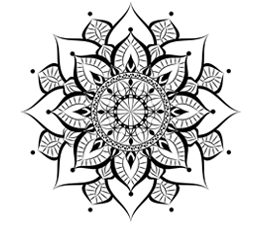Hasta Mudras or hand gestures, hand locks are energetic locks or seals. In Sanskrit, hasta means “hand” and “mudra” means “gesture”, “seal”, “stamp”. So, hasta mudras are hand gestures that seal the energy flow in our body in a particular way and direct it towards the way we want it to go, thus positively act on our mood or make subtle mental and physical changes in our energy body.
Yoni means Womb and so Yoni mudra is representative of Shakti and feminine powers. When practiced it directs the energy downwards towards the womb. It is very powerful mudra offering protection to those practicing it as well as the energy towards which it is directed to (in pregnancy). It is calming and offers relaxation to the practitioner. May be used in the meditative postures or in a flow (as seen in some of our classes) .
Apart from soothing and relaxation, there are physical advantages of this mudra. Prana is all around us and within us and therefore it exist in our hands. This energy is sealed when practicing Yoni mudra and is said that it stimulates the nerves. Interestingly, it is also believed that Yoni Mudra can destroy sins – although this is left to an individual to believe and we are not making any claim to this effect.
Physically, this mudra relates to the pelvis, uterus, womb, sexual organs, and the entire female reproductive system, increasing fertility and helping with menopause.
In Kundalini yoga, Yoni mudra is used to awake kundalini, the spiral coil of energy at the base of the spine. In Nada yoga, it is used to concentrate on inner sounds that one can hear with the ears closed, to become aware of subtle sounds (please note that different hand positions to those below are used in Nada yoga – similar to Bhramari breath). All yoga styles use this mudra to gain relaxation, and to reach higher levels of consciousness. As closely related to goddesses, in Hinduism, Yoni mudra invokes the primal and natural energy of creation – hence its use in pregnancy yoga and yoga for women.
How to perform (in a meditative position):
Sit in a comfortable position or lie down in a supported Butterfly pose (Supta Baddha Konasana). There are two ways of practicing this mudra. One way is by placing your hands on your belly, letting the thumbs and the index fingers touch whilst pointing the fingers down to the womb, and resting the palms against the belly (or Swadhistana chakra). This mudra is practiced in pregnancy and in feminine flow.
The second way of practicing is bringing the tips of the index fingers together and point them downward, creating a triangle-like shape (like above). Interlace the rest of your fingers by curling them upwards. Instead of interlacing, you may also let the backs of middle, ring and little finger touch (as in the picture). Focus on your breath. You may use one of the pranayama techniques
Close your eyes and lips and focus on your womb space. Allow your energy and attention to flow magnifying the pranic energy.
Try to stay with the mudra for at least five minutes or more.
You may wish to flow with this mudra or do pelvic floor exercises, but just performing the Yoni mudra is enough for you to feel more creativity and love, relaxing and connecting to your womb space and your inner goddess energy.
In yoga and Hindu traditions, it is said that this mudra supports the fertility, menstrual and hormonal imbalances, health and urinary issues.
In pregnancy, this mudra is practiced to connect with your baby, to calm and relax and often used in the flow during the practice. Combined with Apana mudra it is used in the final stages of delivery.
If you would like to know more about how this mudra can help you in pregnancy, call us or book on Active Birth workshop or pregnancy yoga.
We hope that you feel the benefits of this mudra and can feel more balance and harmony in your life.



This valuable information regarding yoni mudra. These mudra are very helpful for women. This mudra involves directing energy towards the womb, which can promote relaxation, fertility and hormonal balance. I can’t wait to add them into my daily routine. Thanks for sharing.